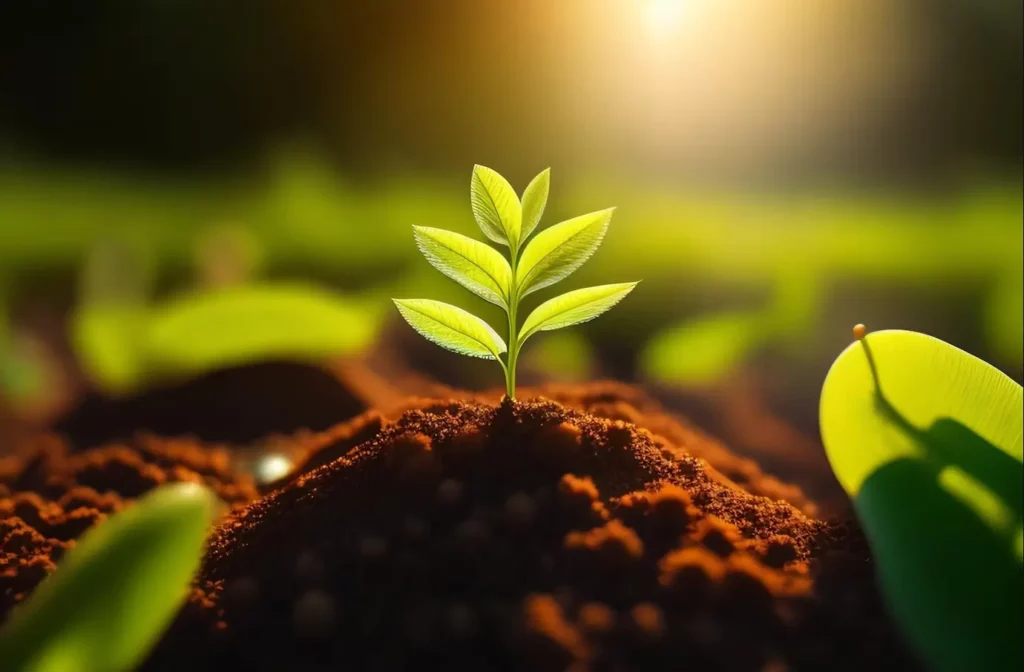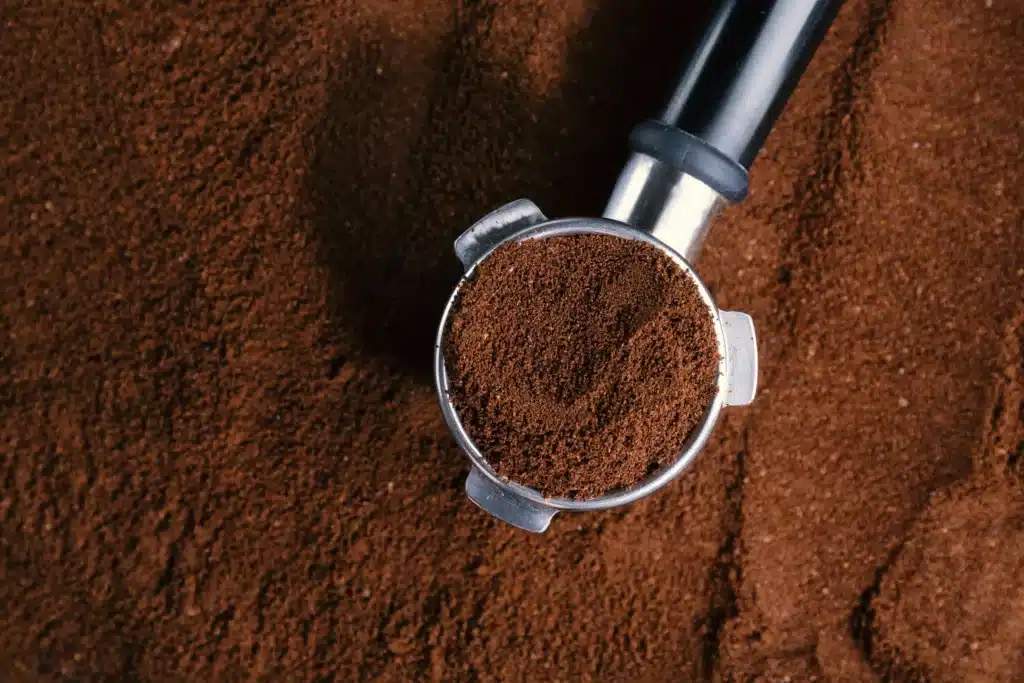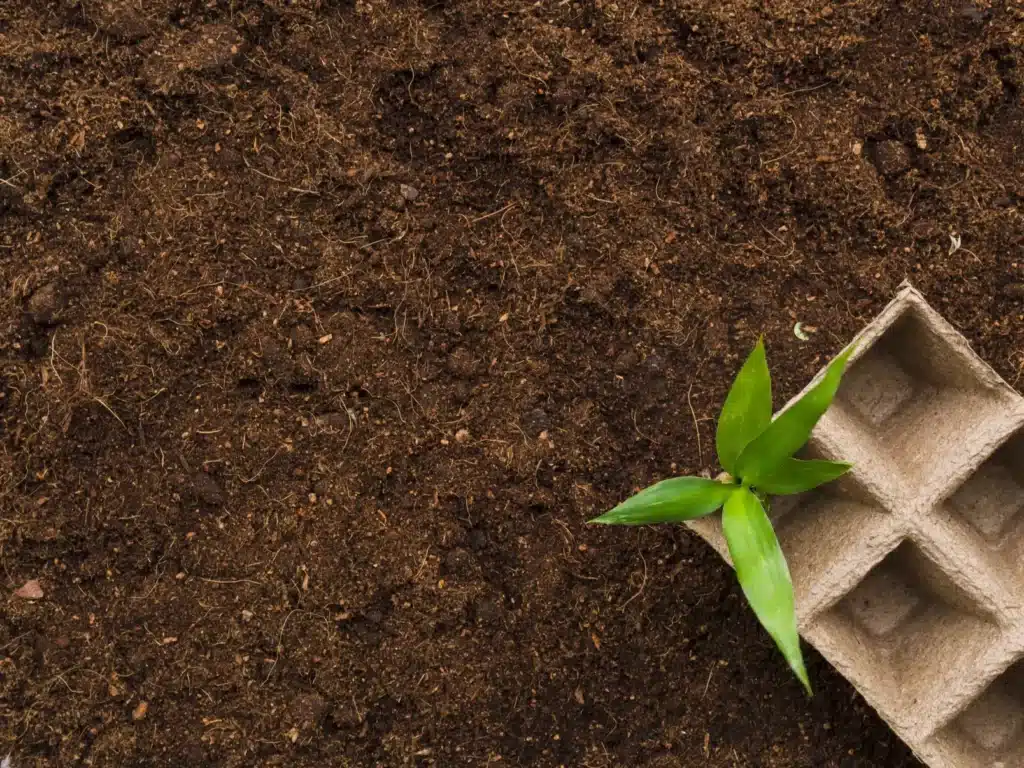
Coffee is very useful to wake up tired bodies during work. But coffee is not only good for humans. Wasted coffee grounds are equally influential on garden plants. Experts are even using waste coffee grounds to boost the growth of their plants.
After brewing coffee in a coffee maker, the wasted coffee grounds contain substantial amounts of nitrogen as well as potassium and phosphorus. These items make coffee grounds suitable for use in gardening, such as composting. It’s a quick way to use something that would otherwise end up in a landfill.
The Nutrient Composition of Coffee Grounds To Soil:
Coffee grounds are the particles left after coffee beans are brewed to extract the flavor and aroma of coffee. These grounds, often discarded after use, contain a variety of substances that are very beneficial to garden plants. Here is a detailed breakdown of their nutritional composition:
- Organic Matter Enrichment: Coffee grounds are considered a valuable source of organic matter. Organic matter is crucial to soil health because it improves its structure, promotes water retention, and promotes beneficial microbial activity. As coffee grounds break down, they add organic matter to the soil, improving its overall fertility and providing habitat for beneficial soil organisms.
- Nitrogen Contribution: Coffee grounds contain significant amounts of nitrogen (Coffee grounds contain approximately 2 percent nitrogen, 0.06 percent phosphorus, and 0.6 percent potassium by volume), a nutrient essential for plant growth. Nitrogen is a primary component of chlorophyll, the molecule responsible for photosynthesis. As the coffee grounds decompose, the nitrogen in them gradually becomes available to the plants in a form they can absorb. This natural nitrogen release acts as a slow-release fertilizer, supporting healthy plant growth.
- Carbon to Nitrogen Balance: The carbon-to-nitrogen (C:N) ratio of coffee grounds is relatively balanced, making them suitable for composting. A balanced C:N ratio is essential for efficient composting, as it promotes the breakdown of organic matter and the release of nutrients. When combined with other compostable materials such as leaves or kitchen scraps, coffee grounds contribute to the creation of nutrient-rich compost.
- Improved Water Retention: Coffee grounds have the ability to absorb and retain water. By incorporating coffee grounds into the soil, you can improve its water holding capacity. It can be particularly beneficial in areas with irregular rainfall patterns or soils prone to rapid drying. Increased water retention helps maintain consistent moisture levels for plant roots.
- Microbial Activation: Coffee grounds promote the growth of beneficial microorganisms in the soil. Microbes break down organic matter, releasing essential nutrients in a form that plants can use. A rich microbial community supports nutrient cycling and contributes to the overall health of the soil ecosystem.
- Enhanced Aeration: The grainy texture of coffee grounds contributes to improved soil aeration. Mixing coffee grounds into the soil creates small pockets of air, preventing soil compaction and allowing better circulation of oxygen to plant roots. Proper aeration enhances root growth and nutrient uptake.
- Waste reduction: Incorporating coffee grounds into the soil presents an eco-friendly approach to waste management. Instead of discarding used coffee grounds, reusing them in the garden reduces the amount of organic material sent to landfills.
When using coffee grounds in the soil, it is important to consider the following:
- Moderation: Although coffee grounds offer benefits, it is important to use in moderation. Excessive application can alter pH levels or create nutrient imbalances.
- Mixing: To avoid clumping and ensure even distribution of nutrients, mix coffee grounds with other compostable materials.
- Plant Preferences: Some plants, like those that prefer slightly acidic conditions, benefit more from coffee grounds. Research your plant’s specific needs before adding coffee grounds to the soil.
- Composting: If you’re not going to use coffee grounds right away, consider composting them first. This allows decomposition and release of nutrients over time.
Coffee Grounds and Soil pH:
Understanding the pH dynamics of coffee grounds is key to reaping their benefits. We explore the role of acidity in soil pH, its effects on plant health, and the plants that thrive in these slightly acidic conditions.
Coffee grounds have a slightly acidic pH due to the presence of organic acids such as chlorogenic acid. When combined with soil, they can slowly lower its pH, making it more acidic. This can be advantageous for plants that grow in slightly acidic conditions, such as blueberries, rhododendrons, and azaleas.

Coffee Grounds as Organic Matter:
Coffee grounds are commonly used as organic matter in gardening and composting due to their rich nutrient content and organic composition. Here are some key points about using coffee grounds as compost:
- Worm Beans: Coffee grounds are also used in vermicomposting, in which worms are used to break down the organic matter into nutrient-rich castings (worm poop). Worms enjoy feeding on the coffee grounds and their digestive processes increase the nutrient content of the resulting compost.
- Mulching: Coffee grounds can be used as mulch around plants. They help retain moisture in the soil, suppress weed growth and slowly break down nutrients.
- Caution: Although coffee grounds have many benefits, it is important to use them in moderation. Too much can cause an imbalance in soil pH and excessive nitrogen levels, which can be detrimental to plant health. Additionally, if you use coffee grounds from a coffee shop, make sure they are not mixed with non-organic materials such as plastic filters.
- Drying: It is a good idea to dry the coffee grounds before composting or using them directly on the soil. Wet coffee grounds can clump together and create anaerobic (low oxygen) conditions in the compost pile.
- Plant Diversity: While coffee grounds can be beneficial to many plants, some cannot tolerate acidic nature or excess nitrogen. It is best to research the specific needs of the plants you are growing before applying coffee grounds.
Composting Coffee Grounds:
Composting coffee grounds involves reusing used coffee grounds to enrich the soil in a sustainable manner. By integrating coffee grounds into the composting process, a valuable resource is added to the mix. Coffee grounds contain substantial nitrogen content, making them an effective “green” material in the composting process, complementing “brown” materials such as leaves and paper. The combination of coffee grounds with these other ingredients initiates a natural decomposition process, facilitated by organisms such as microorganisms and worms. Over time, this cooperation transforms the mixture into nutrient-rich compost. The resulting compost, mixed with the benefits of coffee grounds, improves soil quality, provides essential nutrients to plants, and promotes healthy growth. In essence, composting coffee grounds is a simple yet powerful way to recycle waste, nurture the environment, and practice more productive and sustainable gardening.
Applying Coffee Grounds to Different Soil Types:
The practice of applying coffee grounds to soil utilizes this resource across a wide variety of soils. Coffee grounds, a rich source of nutrients and organic matter, can be beneficially incorporated into various soils. When coffee grounds are added to the soil, their nitrogen content acts as a valuable supplement, especially for increasing the fertility of nutrient-deficient soils. In sandy soils, coffee grounds can help retain moisture and nutrients, improving overall soil structure. For clay soils, coffee grounds contribute to good drainage and aeration, preventing compaction. Additionally, coffee grounds act as a pH buffer, helping to maintain optimal pH levels in acidic soils. By incorporating coffee grounds into the soil, a harmonious combination is established that enriches its structure, promotes healthy plant growth, and supports sustainable horticultural practices.
Experimentation and Best Practices:
Experiments and best practices on the incorporation of coffee grounds into the soil provide valuable insight into optimizing orchard results. The process of introducing coffee grounds into the soil involves some experimentation to determine the correct ratio and frequency for each specific plant type and soil composition. Although coffee grounds bring many benefits, excessive consumption can lead to imbalance. It is recommended to start with a moderate amount and observe the soil’s reaction, gradually increase the amount if necessary. Mixing coffee grounds with other compost materials such as leaves and kitchen scraps encourages a well-rounded compost mix. To avoid clumping, it is recommended to combine the coffee grounds with other compost materials or dry leaves before incorporating them into the soil. Additionally, different soil types require different methods; For example, sandy soils can benefit from increased water retention, while clay soils can use better aeration. By mixing experimentation with established guidelines, individuals can harness the benefits of adding coffee grounds to soil while tailoring their practices to ensure optimal plant growth and soil health.

Case Studies and Real-Life Examples:
Growing up, my father always produced an enviable garden, and his trees were always vigorous and healthy. Dad put everything that could be composted into his garden, and while he was not a coffee connoisseur, he was always adamant about saving the coffee grounds from my mom’s daily coffee. He claimed coffee grounds were the secret to his prolific garden, as well as his healthy and bug-free grass and trees. So, were the coffee grounds really the secret ingredient for successful gardening, or was my father just born with a green thumb? With a quick internet search, you can find a plethora of information on using coffee grounds for gardening, ranging from blogs, forums, and magazine articles to some actual scientific research.
Brown gold for the garden
Coffee grounds are praised for acidifying the soil, disease control, enhanced plant growth, and improved soil tilth. There are many theories about the benefits of using coffee grounds in gardens and landscapes, but let’s start with a few coffee ground facts:
- Coffee grounds contain approximately 2 percent nitrogen, 0.06 percent phosphorus, and 0.6 percent potassium by volume. They also contain many micronutrients, including calcium, magnesium, boron, copper, iron, and zinc.
- The nitrogen in coffee grounds is primarily found in proteins and other organic molecules that are unavailable to the plants until soil microorganisms break them down into simple ions. As a result, the nitrogen in coffee grounds is released slowly over time as the plants need it.
- Coffee grounds are slightly acidic (5.5 to 6.8 pH).
- Coffee grounds make an excellent compost feedstock, with a carbon/nitrogen ratio of 20–24:1.
- The use of coffee grounds in amending mineral soils up to 35 percent by volume has been shown to improve soil structure both short-term and long-term while improving the availability of phosphorus, potassium, magnesium, and copper.
- Humic substances, which are the major organic constituents of the soil (humus), are produced through coffee ground degradation.
- Coffee grounds can moderate soil temperatures and increase soil water retention.
- Coffee grounds, along with other sources of soil organic matter, can bind pesticide residues, preventing their movement into the surrounding environment. Based on these facts, what are the significant uses for leftover coffee grounds in your garden or landscaping?
Real Life Case Study: PLANTS WITH PERK – University of Wyoming
Potential Concerns and Considerations:
While using coffee grounds in the garden can be beneficial, there are potential concerns and considerations that need to be taken into account. When incorporating coffee grounds into the soil, it is important to remember that they are relatively high in nitrogen, which if overapplied can lead to an imbalance in nutrient levels. This can potentially inhibit the growth of some plants or even cause nutrient toxicity. Additionally, coffee grounds can be acidic, which may not suit all plants and soil types. It is very important to monitor soil pH and its effect on plants. Another concern is the tendency of coffee grounds to compact and prevent water penetration if overused. This can result in poor drainage and aeration, especially in clay-heavy soils. To address these concerns, it is recommended to mix coffee grounds with other compost materials and follow the recommended guidelines for application. By carefully considering these factors and adjusting practices accordingly, gardeners can reap the benefits of coffee grounds while avoiding potential losses and ensuring optimal plant health and soil quality.
Conclusion:
In gardening, the incorporation of coffee grounds into the soil presents a remarkable combination between the natural world and the daily comfort of our routine. Through this exploration, we uncovered the complex dance of nutrients, pH, and organic matter that coffee grounds bring to the orchard stage. Infusing the soil with their rich nitrogen content and contributing to improved structure, coffee grounds offer a nutritious embrace to plant life. The delicate pH balance they introduce can be the perfect tune for certain plants, adding a delicate level of care to our cultivation practices. As we embark on this journey, it is clear that recognizing the nuances and embracing the dynamic interplay between coffee grounds and soil health is key. In a world where sustainability and resourcefulness reign supreme, repurposing coffee grounds for our gardens stands as a testament to the art of giving back to the earth what it so generously provides. So, whether you’re nurturing a rich vegetable patch, cultivating a flower bed, or covering life with a potted paradise, the infusion of coffee grounds into the soil echoes the rhythm of growth and renewal—an eco-friendly note in the symphony of gardening.
Why would I consider adding coffee grounds to soil for plant growth?
Coffee grounds can enhance soil structure, increase nutrient availability, and even deter pests. Their organic matter and nutrient content make them valuable additions to your gardening practices.
What nutrients do coffee grounds provide to the soil?
Coffee grounds are rich in nitrogen, potassium, phosphorus, magnesium, and calcium. These nutrients contribute to healthy plant growth, root development, and overall vitality.
Can coffee grounds improve soil structure?
Yes, coffee grounds act as organic matter that improves soil structure. They enhance soil’s water retention, aeration, and drainage properties, creating an environment conducive to plant growth.
Can I use coffee grounds for any type of plant?
While coffee grounds are generally beneficial, not all plants appreciate acidic soil or high nitrogen content. Acid-loving plants like roses, azaleas, and tomatoes tend to benefit the most.
Can I apply coffee grounds directly or should they be composted first?
While adding coffee grounds directly can work, composting them first is advisable. Composting helps break down the grounds, reducing their acidity and allowing for better nutrient release.
